|
| |
Saint Andrew,
Patron Saint of Scotland
compiled by Elizabeth Mckaskle |
 |
Saint
Andrew is the Patron Saint of Scotland, and St. Andrew's Day is celebrated by Scots around
the world on the 30th November. The flag of Scotland is the Cross of St. Andrew, and this
is widely displayed as a symbol of national identity.
The "Order of Saint Andrew" or the "Most Ancient Order of the Thistle"
is an order of Knighthood which is restricted to the King or Queen and sixteen others. It
was established by James VII of Scotland in 1687.
A disciple of Jesus and the brother of Simon Peter . The two are pictured as fishermen
working beside the sea when Jesus summons them to follow him and become, "fishers of
men." Although less prominent than his brother, Andrew is present at the miracle of
the bread and the speech on the Mount of Olives. In the list of the Twelve, Andrew
is listed second in Luke and Matthew and fourth in the books of Mark and Acts. In all
accounts he was one of the first, as a follower of John the Baptists, to be
"called" a disciple.
According to later traditions , Andrew became a missionary to Asia Minor, Macedonia, and
southern Russia. In 70 AD he was martyred in Patras, Greece. Having many coverts, he
was feared by the Roman governor who had him cruxified on an X-shaped cross known as a
Saltire Cross. (One of the many Medievil customs of torture). It is this shape
that is reflected in the Scottish flag. ( for culture buffs who attribute the
southern "bubba or redneck" culture to early Scottish settlers, take note of the
similiar designs between the Scottish flag and the Confederate flag).
He was the patron saint of Greece, Russua and Of course Scotland. St. Andrew is also
invoked against gout and a stiff neck.
St. Andrews bones were entombed, and around 300 years later were moved by Emperor
Constantine (the Great) to his new capital Constantinople. Legend suggests that a
Greek Monk (although others describe him as an Irish assistant of St. Columba) called St.
Rule (or St. Regulus) was warned in a dream that St. Andrews remains were to be moved and
was directed by an angel to take those of the remains which he could to the "ends of
the earth" for safe-keeping. St. Rule dutifully followed these directions, removing a
tooth, an arm bone, a kneecap and some fingers from St. Andrew's tomb and transporting
these as far away as he could. That place was Scotland and it is here the association is
believed to have begun. It was here that St. Rule was shipwrecked with his precious
cargo.
St. Rule is said to have come ashore at a Pictish settlement on the East Coast of Scotland
and this later became St. Andrews.
Another story is that Acca, the Bishop of Hexham, who was a reknown collector of relics,
brought the relics of St. Andrew to St. Andrews in 733. There certainly seems to have been
a religious center at St. Andrews at that time, either founded by St. Rule in the 6th
century or by a Pictish King, Ungus, who reigned from 731 - 761. Whichever tale is true,
the relics were placed in a specially constructed chapel. This chapel was replaced by the
Cathedral of St. Andrews in 1160, and St. Andrews became the religious capital of Scotland
and a great center for Medieval pilgrims who came to view the relics.
There are other legends of how St. Andrew and his remains became associated with
Scotland,but there is little evidence for any of these, including the legend of St. Rule.
The names still exist in Scotland today, including St. Rules Tower, which remains today
amongst the ruins of St. Andrews Cathedral. It is not known what happened to the relics of
St. Andrew which were stored in St. Andrews Cathedral, although it is most likely that
these were destroyed during the Scottish Reformation.
The Protestant cause, propounded by Knox, Wishart and others, won out over Roman Catholism
during the Reformation and the "idolatry of catholism", that is the Saints,
relics, decoration of churches, were expunged during the process of converting the Roman
Catholic churches of Scotland to the harsh simplicity of Knox's brand of Calvanism.
The place where these relics were kept within the Cathedral at St. Andrews is now marked
by a plaque, amongst the ruins, for visitors to see.
The larger part of St. Andrew's remains were stolen from Constantinople in 1210 and are
now to be found in Amalfi in Southern Italy. In 1879 the Archbishop of Amalfi sent a small
piece of the Saint's shoulder blade to the re-established Roman Catholic community in
Scotland. During his visit in 1969, Pope Paul VI gave further relics of St. Andrew to
Scotland with the words "Saint Peter gives you his brother" and these are now
displayed in a reliquary in St. Mary's Roman Catholic Cathedral in Edinburgh.
Compiled by Elizabeth Mckaskle from the following sources:
Gateway to Scotland WP
The Oxford Companion Bible
The Dictionary of Christian Art |
|

Click here to learn about Scotland's Flag
St
Andrew
Scotland's Patron Saint
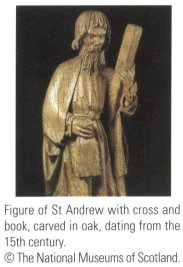 In
most Christian countries and for many centuries the last day in November
has been observed as the feast day of St Andrew. The Church Calendar
begins with Advent (defined as the nearest Sunday to St Andrew’s Day),
and it seems fitting that Andrew, the first of Christ’s disciples,
should have the distinction of coming first in the Church Year. In
Scotland - and wherever else Scots are gathered - November 30th is
celebrated as our national day, for St Andrew is Scotland’s patron
saint and the St Andrew’s Cross (or Saltire) is Scotland’s flag. But
who was St Andrew, and how did he become our patron saint? In
most Christian countries and for many centuries the last day in November
has been observed as the feast day of St Andrew. The Church Calendar
begins with Advent (defined as the nearest Sunday to St Andrew’s Day),
and it seems fitting that Andrew, the first of Christ’s disciples,
should have the distinction of coming first in the Church Year. In
Scotland - and wherever else Scots are gathered - November 30th is
celebrated as our national day, for St Andrew is Scotland’s patron
saint and the St Andrew’s Cross (or Saltire) is Scotland’s flag. But
who was St Andrew, and how did he become our patron saint?
ST
ANDREW THE APOSTLE
 The
Bible tells us that Andrew, a fisherman from Bethsaida in Galilee, was
the ‘first called’ of Christ’s disciples and that he brought his
brother Simon Peter to become a follower of Jesus. After the
Crucifixion, as tradition relates, Andrew travelled the countries
bordering the Black Sea and preached the Gospel in Scythia (as the
Ukraine and Southern Russia were anciently known) and in Greece. (For a
link between Scythia and the Scots, see the part of the Arbroath
Declaration quoted overleaf). His missionary work is still remembered in
that part of the world: to this day Andrew is patron saint in Greece,
Russia and the Ukraine. It was in Greece, in the city of Patras, that he
suffered martyrdom. Possibly because he felt himself unworthy to meet
his death on a cross of the same shape as his Lord’s, he was crucified
on a diagonal cross. The
Bible tells us that Andrew, a fisherman from Bethsaida in Galilee, was
the ‘first called’ of Christ’s disciples and that he brought his
brother Simon Peter to become a follower of Jesus. After the
Crucifixion, as tradition relates, Andrew travelled the countries
bordering the Black Sea and preached the Gospel in Scythia (as the
Ukraine and Southern Russia were anciently known) and in Greece. (For a
link between Scythia and the Scots, see the part of the Arbroath
Declaration quoted overleaf). His missionary work is still remembered in
that part of the world: to this day Andrew is patron saint in Greece,
Russia and the Ukraine. It was in Greece, in the city of Patras, that he
suffered martyrdom. Possibly because he felt himself unworthy to meet
his death on a cross of the same shape as his Lord’s, he was crucified
on a diagonal cross.
Part of the tradition is that St Andrew wore blue, and
so the white of the wooden cross against the blue of his robes gave us
the colours of our national flag. However, there is another legend to
explain the white cross on a blue background, a legend which had its
birth a long way from Greece, in the village of Athelstaneford in East
Lothian.
THE
BATTLE OF ATHELSTANEFORD
According to this legend, an army of
Picts under Angus mac Fergus, High King of Alba, and aided by a
contingent of Scots, had been on a punitive raid in Northumbrian
territory, but were pursued and then confronted by a larger force of
Angles and Saxons under one Athelstan. Defeat seemed almost certain, but
after Angus and his men had prayed for deliverance, the appearance in
the blue sky above them of a white cloud in the shape of a saltire or St
Andrew’s Cross seemed to promise that their prayers had been heeded.
Thereupon Angus vowed that if they were victorious that
 day,
St Andrew would forever after be their patron saint. Victory was indeed
theirs, Angus remembered his vow, and so Andrew became our patron saint
and his cross our flag. The date is believed to have been 832AD. day,
St Andrew would forever after be their patron saint. Victory was indeed
theirs, Angus remembered his vow, and so Andrew became our patron saint
and his cross our flag. The date is believed to have been 832AD.
The battle is commemorated by a
monument in the churchyard at Athelstaneford. Attached is a tall
flagpole on which a Saltire is flown permanently, even during the hours
of darkness when it is floodlit, as a reminder of the flag’s origins.
ST ANDREW AND ST
ANDREWS
Far though he travelled on his missionary journeys, St
Andrew never set foot in the most westerly of the countries which
adopted him as patron saint. But four centuries after his death, some of
his bones arrived here. Quite how they did so is uncertain. One version
of the story is that St Regulus (St Rule) was homeward bound from the
Mediterranean lands with
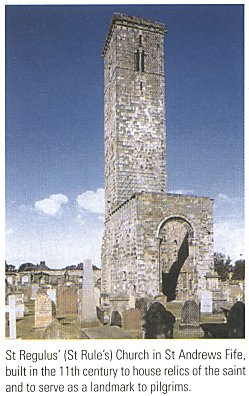 the
relics of the saint he had acquired there when his ship was wrecked on
the coast of Fife. Regulus settled where he had been shipwrecked, at
Kilrymont, and the church which he founded there became an important
place of pilgrimage and the seat of the Bishop of St Andrews. Another
version, favoured by historians, is that some relics of St Andrew found
their way from Constantinople, where the Emperor Constantine the Great
had a collection, via the Italian town of Amalfi to Scotland. But
whatever the truth of the matter, it is clear that the rise to
prominence of St Andrew and the cathedral city bearing his name was
closely linked to changes taking place in Scotland between the 9th and
the 12th centuries. During this period Celtic influences coming from
Ireland and associated with local saints such as Columba had led to the
creation of religious centres at Dunkeld, Abernethy and elsewhere; but
the influence of Rome coming via England was, to prove stronger in the
end, and St Andrews, named after an apostle of the universal church,
became its headquarters. The strength of St Andrews was shown in the
stubborn resistance it offered to the pretensions of the See of York,
which was seeking to extend its jurisdiction over Scotland. The
resistance was successful, and in the end the independence of the
Scottish Church was recognised by the Pope. the
relics of the saint he had acquired there when his ship was wrecked on
the coast of Fife. Regulus settled where he had been shipwrecked, at
Kilrymont, and the church which he founded there became an important
place of pilgrimage and the seat of the Bishop of St Andrews. Another
version, favoured by historians, is that some relics of St Andrew found
their way from Constantinople, where the Emperor Constantine the Great
had a collection, via the Italian town of Amalfi to Scotland. But
whatever the truth of the matter, it is clear that the rise to
prominence of St Andrew and the cathedral city bearing his name was
closely linked to changes taking place in Scotland between the 9th and
the 12th centuries. During this period Celtic influences coming from
Ireland and associated with local saints such as Columba had led to the
creation of religious centres at Dunkeld, Abernethy and elsewhere; but
the influence of Rome coming via England was, to prove stronger in the
end, and St Andrews, named after an apostle of the universal church,
became its headquarters. The strength of St Andrews was shown in the
stubborn resistance it offered to the pretensions of the See of York,
which was seeking to extend its jurisdiction over Scotland. The
resistance was successful, and in the end the independence of the
Scottish Church was recognised by the Pope.
The country’s political
independence, restored by the heroic efforts culminating in Bannockburn,
was given its most eloquent expression in the Declaration of Arbroath,
and in 1385 an Act of Parliament established the statutory position of
the St Andrew’s Cross as the national flag which any Scot is entitled
to fly or display.
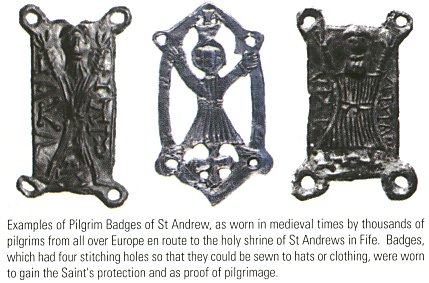
The Arbroath Declaration (1320)
relates with pride the country’s link with St Andrew and the scene of
his missionary labours:
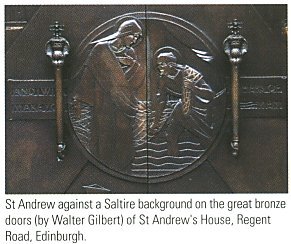 "Among other distinguished nations our
own nation, namely of Scots, has been marked by many distinctions. It journeyed from
Greater Scythia ... but
nowhere could it be subjugated by any people it acquired, with many
victories and untold efforts, the places which it now holds, although often
assailed by Norwegians. Danes and English. "Among other distinguished nations our
own nation, namely of Scots, has been marked by many distinctions. It journeyed from
Greater Scythia ... but
nowhere could it be subjugated by any people it acquired, with many
victories and untold efforts, the places which it now holds, although often
assailed by Norwegians. Danes and English.
"Our Lord Jesus Christ ...
called them ... almost the first to his most holy faith. Nor
did he wish to confirm them in that faith by anyone but by the first
apostle by calling. ... namely the most
gentle Andrew, the blessed Peter’s brother, whom he wished to protect
them as their patron for ever".
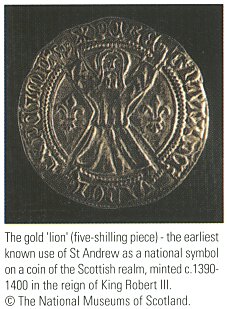 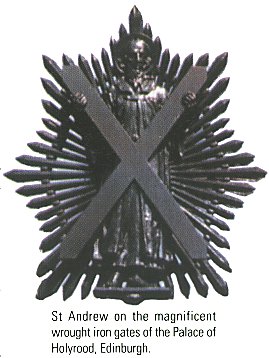 |
Return
to our Significant Scots page
|

